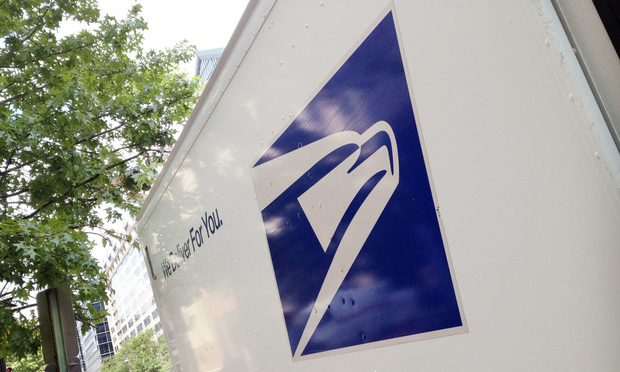Sotomayor Joins Conservatives in Key Patent Ruling
The justices ruled that the definition of “person” does not include the government when it comes to having standing to challenge a patent.
June 10, 2019 at 11:04 AM
6 minute read
 U.S. Postal Service truck. Photo: Diego M. Radzinschi/ALM
U.S. Postal Service truck. Photo: Diego M. Radzinschi/ALM
The government is not a “person” that has standing to challenge a patent under the America Invents Act, the U.S. Supreme Court ruled Monday.
The justices ruled 6-3 that while the AIA does not define a “person” in the statute, the court applied a long-standing interpretation that it does not include federal agencies such as the U.S. Postal Service. The justices said a person has been defined to include corporations, companies, associations, firms, partnerships, societies, and joint stock companies, as well as individuals, but it does not include the government.
“This presumption reflects 'common usage,'” Justice Sonia Sotomayor wrote. “It is also an express directive from Congress: The Dictionary Act has since 1947 provided the definition of 'person' that courts use '[i]n determining the meaning of any Act of Congress, unless the context indicates otherwise.'”
Sotomayor was joined by Chief Justice John Roberts Jr., and Justices Clarence Thomas, Neil Gorsuch, Samuel Alito and Brett Kavanaugh. Justice Stephen Breyer filed a dissenting opinion, which was joined by Justices Ruth Bader Ginsburg and Elena Kagan.
Breyer said the presumption is not “a hard and fast rule” and the statute must be examined in context. It “makes little sense to presume that the word 'person' excludes the Government,” he wrote, given that surrounding provisions “point to the opposite conclusion.”
➤➤ You can find all of the latest IP news in Scott Graham's newsletter, Skilled in the Art. Sign up here.
Covington & Burling partner Beth Brinkmann had the winning argument for patent owner Return Mail Inc. Deputy Solicitor General Malcolm Stewart argued for the government.
Brinkmann, who is co-chairwoman of Covington's appellate and Supreme Court litigation group, had argued that the government has plenty of opportunities to challenge patent validity, whether through ex parte reexaminations or in court. “The court's decision confirms that federal agencies do not get an extra chance to challenge privately held patents under the AIA,” said Brinkmann, who had help on the case from Covington partners Richard Rainey, Kevin King and others.
She also had help from Federal Circuit Judge Pauline Newman, who raised the issue sua sponte in a dissent at the appellate court.
Return Mail owns U.S. Patent 6,826,548, which claims a method for processing mail that is undeliverable, according to Sotomayor's opinion. Beginning in 2003, USPS allegedly began exploring the possibility of licensing Return Mail's invention, but the parties never reached an agreement. Then in 2006 USPS introduced an enhanced address-change service that Return Mail said infringed the patent.
Return Mail sued in the Court of Federal Claims, and the government sought AIA review. The suit has been on hold for several years while the AIA proceedings and appeals played out.
Under the AIA, almost anyone can ask the Patent Trial and Appeal Board to review the validity of a patent. Specifically, the AIA states that “a person who is not the owner of patent” may petition for inter partes review of a patent, and any person who's been sued for infringement may petition for covered business method review. Both are administrative procedures for determining patent validity at the PTAB.
Corporations are generally understood to be “persons” under the law, and Return Mail apparently thought the government would qualify, too. It didn't challenge the government's authority to petition when it was before the PTAB or at the U.S. Court of Appeals for the Federal Circuit.
Monday's decision vindicates Newman, who concluded in Return Mail v. USPS that the PTAB didn't have statutory jurisdiction to take up the case and invalidate Return Mail's patent. “The general statutory definition is that a 'person' does not include the United States and its agencies unless expressly provided,” Newman wrote.
Sotomayor agreed with that presumption Monday, and found nothing in the text of the AIA to rebut it. “The Patent Act and the AIA refer to 'person[s]' in at least 18 different places, and there is no clear trend: Sometimes 'person' plainly includes the Government, sometimes it plainly excludes the Government, and sometimes—as here—it might be read either way,” she wrote.
She also noted that when the government is accused of patent infringement, it doesn't face the risk of injunctions or damages beyond reasonable compensation. “Because federal agencies face lower risks, it is reasonable for Congress to have treated them differently,” she wrote.
In dissent, Breyer argued that the AIA's goal of providing an easier way to challenge weak patents should apply equally whether it's the government or a private party that's accused of infringing.
“Why,” Breyer asked, “would Congress have declined to give federal agencies the power to invoke these same administrative procedures? I see no good answer to that question.”
Baker Botts partner Eliot Williams said he does not expect the decision to have much impact beyond the parties. “Practically speaking, there are just not that many cases where the federal government is a petitioner,” he said.
According to Return Mail, before passage of the AIA, there were 2,000 requests for inter partes reexamination and only one was instigated by the government. Under the AIA, the government has filed only “a handful” of petitions, according to Return Mail.
This is only the fourth decision from the Supreme Court interpreting AIA procedures at the PTAB, so practitioners who appear there are always looking for clues to other hot-button issues.
Williams said that parties seeking to expand constitutional standing for PTAB appeals to the Federal Circuit might seize on a statement in Sotomayor's opinion: “Any party 'dissatisfied' with the Board's final decision may seek judicial review in the Court of Appeals for the Federal Circuit.”
But Williams said Sotomayor was more likely referring to the statutory requirements, rather than making “a bold statement” about constitutional standing.
Ropes & Gray partner Matthew Rizzolo noted that Sotomayor wrote that AIA proceedings are “adversarial, adjudicatory proceedings between the 'person' who petitioned for review and the patent owner.” States will likely point to that language as supporting their contention that sovereign immunity should shield their patents from AIA review, Rizzolo said. Petitioners argue that AIA proceedings are merely the PTO taking a “second look” at the issuance of a patent, with the director acting as gatekeeper of the proceedings.
“If I'm someone who wants to see state sovereign immunity weighed in on by the Supreme Court, this opinion certainly encourages that,” Rizzolo said.
Read the decision
This content has been archived. It is available through our partners, LexisNexis® and Bloomberg Law.
To view this content, please continue to their sites.
Not a Lexis Subscriber?
Subscribe Now
Not a Bloomberg Law Subscriber?
Subscribe Now
NOT FOR REPRINT
© 2025 ALM Global, LLC, All Rights Reserved. Request academic re-use from www.copyright.com. All other uses, submit a request to [email protected]. For more information visit Asset & Logo Licensing.
You Might Like
View All

SEC Official Hints at More Restraint With Industry Bars, Less With Wells Meetings
4 minute read

Sidley Adds Ex-DOJ Criminal Division Deputy Leader, Paul Hastings Adds REIT Partner, in Latest DC Hiring
3 minute readTrending Stories
Who Got The Work
J. Brugh Lower of Gibbons has entered an appearance for industrial equipment supplier Devco Corporation in a pending trademark infringement lawsuit. The suit, accusing the defendant of selling knock-off Graco products, was filed Dec. 18 in New Jersey District Court by Rivkin Radler on behalf of Graco Inc. and Graco Minnesota. The case, assigned to U.S. District Judge Zahid N. Quraishi, is 3:24-cv-11294, Graco Inc. et al v. Devco Corporation.
Who Got The Work
Rebecca Maller-Stein and Kent A. Yalowitz of Arnold & Porter Kaye Scholer have entered their appearances for Hanaco Venture Capital and its executives, Lior Prosor and David Frankel, in a pending securities lawsuit. The action, filed on Dec. 24 in New York Southern District Court by Zell, Aron & Co. on behalf of Goldeneye Advisors, accuses the defendants of negligently and fraudulently managing the plaintiff's $1 million investment. The case, assigned to U.S. District Judge Vernon S. Broderick, is 1:24-cv-09918, Goldeneye Advisors, LLC v. Hanaco Venture Capital, Ltd. et al.
Who Got The Work
Attorneys from A&O Shearman has stepped in as defense counsel for Toronto-Dominion Bank and other defendants in a pending securities class action. The suit, filed Dec. 11 in New York Southern District Court by Bleichmar Fonti & Auld, accuses the defendants of concealing the bank's 'pervasive' deficiencies in regards to its compliance with the Bank Secrecy Act and the quality of its anti-money laundering controls. The case, assigned to U.S. District Judge Arun Subramanian, is 1:24-cv-09445, Gonzalez v. The Toronto-Dominion Bank et al.
Who Got The Work
Crown Castle International, a Pennsylvania company providing shared communications infrastructure, has turned to Luke D. Wolf of Gordon Rees Scully Mansukhani to fend off a pending breach-of-contract lawsuit. The court action, filed Nov. 25 in Michigan Eastern District Court by Hooper Hathaway PC on behalf of The Town Residences LLC, accuses Crown Castle of failing to transfer approximately $30,000 in utility payments from T-Mobile in breach of a roof-top lease and assignment agreement. The case, assigned to U.S. District Judge Susan K. Declercq, is 2:24-cv-13131, The Town Residences LLC v. T-Mobile US, Inc. et al.
Who Got The Work
Wilfred P. Coronato and Daniel M. Schwartz of McCarter & English have stepped in as defense counsel to Electrolux Home Products Inc. in a pending product liability lawsuit. The court action, filed Nov. 26 in New York Eastern District Court by Poulos Lopiccolo PC and Nagel Rice LLP on behalf of David Stern, alleges that the defendant's refrigerators’ drawers and shelving repeatedly break and fall apart within months after purchase. The case, assigned to U.S. District Judge Joan M. Azrack, is 2:24-cv-08204, Stern v. Electrolux Home Products, Inc.
Featured Firms
Law Offices of Gary Martin Hays & Associates, P.C.
(470) 294-1674
Law Offices of Mark E. Salomone
(857) 444-6468
Smith & Hassler
(713) 739-1250








